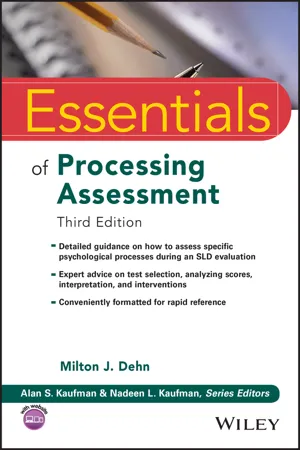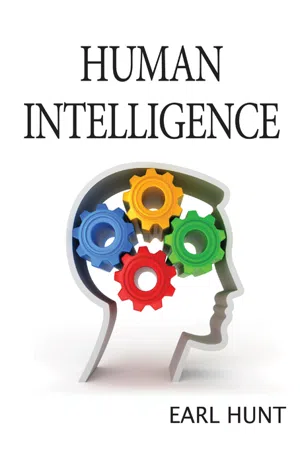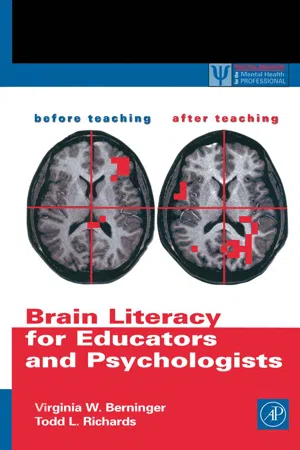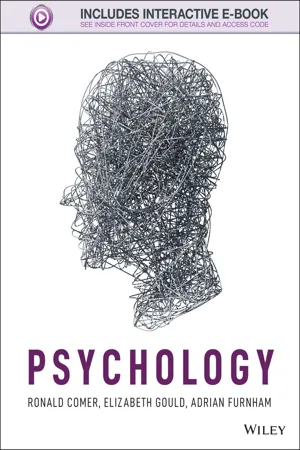Psychology
Brain Structure
The brain structure refers to the physical arrangement of the brain's components, including the cerebral cortex, cerebellum, and brainstem. These components are responsible for various functions such as cognition, emotion, and motor control. Understanding brain structure is crucial in studying how different areas of the brain contribute to behavior, thoughts, and emotions.
Written by Perlego with AI-assistance
Related key terms
1 of 5
10 Key excerpts on "Brain Structure"
- eBook - ePub
- Milton J. Dehn, Alan S. Kaufman, Nadeen L. Kaufman, Alan S. Kaufman, Nadeen L. Kaufman(Authors)
- 2022(Publication Date)
- Wiley(Publisher)
Three THE NEUROPSYCHOLOGY OF PSYCHOLOGICAL PROCESSESThe main purpose of this chapter is to provide an overview of the Brain Structures and functions involved in each of the 14 psychological processes. Knowing some basics about the neuroanatomy of psychological processes can enhance our understanding of how brain‐based processes influence learning and how dysfunctions or deficits in specific neuropsychological processes can impair specific types of learning and performance. Neuroanatomy also illustrates how and why some psychological processes are interrelated. For example, impairment in a visual pathway that connects the occipital and temporal lobes may account for a deficit in rapid automatic naming, a task that, on the surface, appears to depend primarily on memory processes.The human brain is incredibly complex, and much of its functioning is not fully understood. Some of the 14 processes can be more readily mapped to specific brain regions and structures than others. However, most brain‐processing relationships involve interrelated brain networks; very few specific processes function in just one Brain Structure. This chapter will not review all brain anatomy or all types of processing but focuses mainly on the 14 processes and the primary Brain Structures involved in these specific processes. Detailed neuroanatomy of several of the 14 processes can be found in Miller and Maricle (2019 ). For more details on brain anatomy, see Carter et al. (2019 ), Hale and Fiorello (2004 ), and Reynolds and Fletcher‐Janzen (1997 ).OVERVIEW OF Brain StructureS AND FUNCTIONS
Brain Cells
The brain's nerve cells, known as neurons, make up less than 10% of the brain's volume. The remaining cells, known as glial cells, are support cells that provide such functions as supplying the neurons with glucose. What allows the brain to function as an integrated whole is the ability of each neuron to send and receive signals with countless neurons. Signals are sent out from a neuron on a long, thin extension known as an axon. Receiving the signals are numerous, shorter extensions known as dendrites. The axons and dendrites exchange signals across a small gap known as a synapse. Most growth in brain size after birth results from myelination - Available until 4 Dec |Learn more
Psychological Criminology
An Integrative Approach
- Richard Wortley(Author)
- 2011(Publication Date)
- Willan(Publisher)
Examined in this chapter is the pivotal role in criminal behaviour played by the brain as it mediates between internal biological inputs and external environmental inputs. The area of psychology concerned with Brain Structure and function is neuropsychology. Neuropsychologists examine the biological events in the brain that underlie human action, emotion and thought, including those associated with criminal behaviour. They are concerned with both normal Brain Structures and functions, and with the behavioural implications of brain impairments. We begin with an overview of the general field of neuropsychology, before moving to a more specific discussion of neuropsychological correlates and explanations of criminal behaviour.Basic Brain Structures and FunctionsNeuropsychology, like behavioural genetics, is a specialist field and it is beyond the scope of this book to cover it in detail here. What follows, then, is a simplified description of basic Brain Structures and functions that are especially relevant to neuropsychological explanations of crime.The Nervous SystemThe brain is part of the body’s nervous system, a network of nerve cells – or neurons – that is responsible for all psychological, behavioural and physiological activity. The basic job of a neuron is to relay information. Neurons come in a variety of shapes and have different specialised functions, but most comprise four main structures. The body of the neuron is called the soma and houses the basic machinery of the cell. Extending from the soma are tree-like fibres – hundreds or even thousands in number – called dendrites, which have receptors responsible for receiving messages from other neurons. Also extending from the soma is a slender tube called an axon, which is responsible for sending messages. The axon divides and branches, and at the ends of the branches are terminal buttons from which the messages are sent. A simplified diagram of a neuron is shown in Figure 4.1.Figure 4.1A neuron.The nervous system is divided into two parts: the central nervous system (CNS) and the peripheral nervous system (PNS) (see Figure 4.2). The CNS comprises the brain and the spinal cord and is the body’s ‘command centre’. The brain receives and processes stimuli from inside and outside of the body, it interprets and stores information, and it dispatches messages to initiate responses. The spinal cord is connected to the base of the brain and primarily acts as a conduit between the brain and the rest of the body below the neck. - eBook - PDF
Brain Policy
How the New Neuroscience Will Change Our Lives and Our Politics
- Robert H. Blank(Author)
- 1999(Publication Date)
- Georgetown University Press(Publisher)
The Brain: Structure, Development, and Death The brain has long been the subject of considerable speculation, myth, and misconception. Throughout history it has remained a mysterious and enigmatic entity: hidden within the skull, it represented a dark territory, little understood. Major technological developments in imaging the brain combined with leaps in knowledge about its functioning, however, have vastly expanded our understanding of its role in the last several decades. The evolving neuroscience perspective promises to help explain much about the biological bases of human behavior, consciousness, memory, language, and other attributes that make us what we are. Combined with research in molecular biology and other life sciences, our knowledge in neuroscience provides the key to understanding the foundations of human capacity as well as mental and behavioral dysfunction. This chapter first summarizes current knowledge about the anatomy, development, and functioning of the central nervous system. It then de-scribes the growing array of technologies that allow us to probe deeply into the recesses of the brain and examines the implications of those technologies. Finally, it examines the concept of brain death and its impact on the way we view life. ANATOMY OF THE NERVOUS SYSTEM One cannot appreciate the complexity of the subject matter of neuroscience without at least a rudimentary understanding of the structure of the human nervous system. Although all animals have nervous systems, the uniqueness of the anatomy of the human brain is crucial to explaining its functioning and the problems that arise when it fails to function nor-mally. This first section provides a brief overview of the key components of the human nervous system, with special attention to those structural 23 2 24 The Brain: Structure, Development, and Death characteristics which are essential to clarifying the centrality of the ner-vous system to our very definition of what it is to be a human. - Anton Yasnitsky, René van der Veer, Michel Ferrari(Authors)
- 2014(Publication Date)
- Cambridge University Press(Publisher)
(p. 2) Similarly, neuroscientists may decide that they are studying human mind from now on; but they cannot decide that psychology shall become a part of neuroscience. In fact, the opposite is true, neuroscience should be a part – a part that complements other parts – of the approaches to the study of human nature. Cerebral organization of psychological functions The question of cerebral organization of psychological functions is far from being understood today despite numerous advancements in technology that allow us to study Brain Structure and physiology in vivo. There are two interrelated matters that cultural-historical neuropsychology aims to resolve. First, the relation of a psychological function to the brain is understood when its systemic localization is described. It is necessary to reveal all the localized subprocesses and the ways in which these precise localizations are functionally related. A substantial amount of neuropsychological research today is dedicated to studying functions of certain brain regions as if they can be isolated from the whole system that underlies a psychological process. This approach is very likely to give misleading results because it is not possible to detect what functional properties of the studied area are inherent and what properties actually are emergent properties that come to being because this or that brain region became part of a whole system – it is a structural systemic principle that properties of components change when they are included in a higher-order structure. The whole can never be ignored if the properties of the parts are studied. Second, the actual function of localized areas should be studied. The major problem that is commonly ignored is that the same region participates in many different psychological functions. If functions of the regions are studied in relation to psychological functions one by one, the real function of the region is very hard to reveal.- eBook - PDF
Autism Spectrum Disorders
Psychological Theory and Research
- Dermot Bowler(Author)
- 2006(Publication Date)
- Wiley(Publisher)
8 Psychology, Autism and the Brain One of the most spectacular developments in recent decades has been the exponential growth in the study of those brain and neural systems that are thought to underlie the behavioural manifestations of ASD. Initial specula-tions about the role of particular Brain Structures in autistic symptomatology came from inferences from the behavioural consequences of experimental brain lesions in non-human animals as well as from observations of brain-injured children and adults. Early investigations of Brain Structure relied on standard post-mortem procedures that examined the gross and fine anatomy of the brain. The development of techniques such as computed tomography (CT) and structural magnetic resonance imaging (MRI) have permitted the non-invasive study of the brains of living individuals and the study of brain function has been enhanced by the development of procedures such as those that measure event-related potentials (ERP) as well as by means of imaging techniques such as positron emission tomography (PET), single-photon emis-sion computed tomography (SPECT) and functional magnetic resonance imaging (fMRI). In a book that is primarily about psychology, it is legitimate to question the need for devoting a whole chapter to the study of the brain. The brain is the organ that is most closely involved in the organisation and control of behaviour, and understanding its organisation can give some clues to understanding pathological behaviour. But more importantly, as inferences about brain dysfunction are often made on the basis of performance on behav-ioural and psychological tasks, our speculations about brain dysfunction cru-cially depend on how we conceptualise the psychological functions thought to be measured by these tasks. As we have seen in earlier chapters, this last task is not as straightforward as it might initially seem. - eBook - PDF
- Earl Hunt(Author)
- 2010(Publication Date)
- Cambridge University Press(Publisher)
2 The following two sections provide an introductory discussion of the structure of the brain and of modern technologies for examining Brain Structures and processes. Readers familiar with both topics can jump immediately to section 7 . 3 , which begins the discussion of major findings relating brain variables to intelligence. I urge readers not familiar with Brain Structure or the new technologies to refrain from jumping too quickly. 7 . 1 . The Structure of the Brain The human brain is a swelling that sits at the upper end of the spinal cord. Figure 7 . 1 presents a “cartoon” version of the brain, as viewed from the left. It is divided into four major anatomical structures, called lobes – the frontal, temporal, parietal, and occipi-tal lobes. The occipital lobe, at the back of the brain, is primarily concerned with visual analysis. It also plays a role in visual reason-ing. The cerebellum, sitting below and to the rear of the cerebral cortex, is largely con-cerned with automatic motor coordination, although it does have some function in cognition. 2 I am not arguing for a duality of mind and brain. If we knew the nature of every connection between the approximately five billion neurons in a person’s brain, and if we knew the algorithms the brain uses to activate and alter these connections, we would know everything there is to know about that per-son’s cognition. We are so far from having such knowledge that, for the foreseeable future, there is a place for nonbiological models of intelligence. Frontal lobe Parietal lobe Occipital lobe Temporal l obe Cerebellum Figure 7 . 1 . A sketch of the human brain, seen from the left. Sketch by the author. If you view the brain from above you would see that a deep fissure divides it into left and right hemispheres, connected by neural bundles that bridge the fissure. The largest of these bundles is the corpus callo-sum , which provides the main communica-tion link between the two hemispheres. - eBook - PDF
- Lisa J. Cohen(Author)
- 2016(Publication Date)
- Visible Ink Press(Publisher)
Why do we study the brain? As early as 500 B.C.E., Alcmaeon of Croton identified the brain as the physical seat of the mind. Twenty-five hundred years later, modern science has proven this ancient Greek to be absolutely correct. There is no aspect of psychology that is independent of the brain. The very essence of our humanity—our thoughts, our feelings, our beliefs, and our values—all emerge from this three-pound lump of gray tissue. Moreover, with the remarkable advances of neuroscience in the last few decades, we now know more about the brain and its relationship to the mind than at any other time in human history. What do neuroscientists assume about brain evolution and how does that influence our understanding of the brain? In order to understand brain research, it is important to consider three basic assumptions that neuroscientists make about brain evolution. For one, the brain is believed to carry traces of its evolutionary origins deep within its tissues. Just as we carry traces of our earliest childhood within our adult personalities, the brain carries the history of our whole species within its very anatomy. Secondly, the brain has evolved up and out, so that the lowest and deepest parts of the brain are the oldest. The outermost, uppermost, and the furthest forward brain regions are the youngest on the evolutionary scale. Thirdly, our brains have increased in complexity across evolution. The older structures tend to be simpler and more primitive, both in their anatomy and in the behavioral functions they control. Likewise, the evolutionarily newer structures tend to be more complex. What are the costs and benefits of brain complexity? As Brain Structures have evolved toward greater complexity, we can ask what benefits complexity may offer. Are there any costs? In general, complexity allows for more flexibility. Complex systems have a broader repertoire of responses with which to adapt to complicated or changing circumstances. - Virginia W. Berninger, Todd L. Richards(Authors)
- 2002(Publication Date)
- Academic Press(Publisher)
Much of this literature is in its infancy but nevertheless may be useful in helping educators conceptualize the complexity of what the human brain accomplishes in learning to read, write, and compute. MACROSTRUCTURE Global Appearance and Protective Features Most of the currently used research tools scan the brain or record its activity without observing it directly. In contrast, neurosurgery provides a unique opportunity to view a living human brain directly because preparation for neurosurgery requires removal of a portion of skull (Calvin & Ojemann 1980). Viewing the brain through this opening in the cranium (Greek for mixing bowl), which is a protective bony structure, observers see pinkish brown, soft tissue. The living brain is not gray (or grayish brown) or hard. The brain of a deceased person becomes gray and hard when treated with formalin ( a chemical) or alcohol to preserve it for purposes of analysis. The pinkish color is due to the massive network of blood vessels on the surface. This blood supply is crucial for two reasons. First, blood is the energy source for the glucose that fuels the neural processes of the brain (see Chapter 2). Second, blood also supplies the oxygen, which is needed for burning the glucose to generate metabolic energy; without oxygen brain cells die. The brain receives one-fifth of the blood that the heart pumps. The middle cerebral artery provides the blood for the speech and language areas that are especially important in school learning. However, despite the brain's need for blood, the blood-brain barrier protects the brain from unhealthy substances that may be circulating elsewhere in the body. Glial General Principles of Macrostructure and Macrofunction 35 cells (see Chapter 2) wrap around the blood vessels to prevent many of the molecules in the blood from entering the brain. Only small molecules like oxygen, carbon dioxide, and glucose can enter.- eBook - PDF
- Ronald Comer, Elizabeth Gould, Adrian Furnham(Authors)
- 2014(Publication Date)
- Wiley(Publisher)
Several neuron groups, or nuclei, in the brainstem work together to form an area known as the reticular forma- tion , which is important for sleep and The Brain’s Structural and Functional Organization LEARNING OBJECTIVE 3 List key structures of the brain, and describe their relationships to our behaviour. The brain is divided into regions that serve varying functions. Figure 5.7 shows the major structures of the brain. The fol- lowing descriptions present a bottom–top, old/new account of the brain starting from structures that made up the reptile brain to those that are phylogenetically very new: the brains of human beings. The old structures are important to life; the new ones ensure quality of life. The Brainstem The part of the brain closest to the spinal cord is called the brainstem or medulla . The brainstem is important as neural circuits or neural networks. Given that the human brain contains about 100 billion neurons, each of which receives numerous synaptic inputs from a multitude of other neurons, the computational power of this organ is vast. Some clusters of neurons in specific brain regions communicate more heavily with those of other specific regions; these com- binations participate in certain functions. Neuroscientists have focused attention on individual neural systems in order to better grasp the functioning of neural circuits related to specific behaviours. Some neuroscientists have tried to understand how neural networks operate by creating their own versions: artificial neural networks, or ANNs. Artificial neural networks are sim- plified computer models made up of units that represent neurons together with values that represent the strength of the connections between the neuron units. The first artifi- cial neural network, called Perceptron, was created in 1958 by psychologist Frank Rosenblatt. It was intended to model how the human brain processes visual data and learns to recognize objects. - eBook - PDF
- Karen R. Huffman, Katherine Dowdell, Catherine A. Sanderson(Authors)
- 2017(Publication Date)
- Wiley(Publisher)
The profile drawing in the middle highlights key structures and functions of the right half of the adult brain. As you read about each of these structures, keep this drawing in mind and refer to it as necessary. (The diagram shows the Brain Structures as if the brain were split vertically down the center and the left hemisphere were removed.) Brain Organization Having studied the tools scientists use for exploring the brain, we can now begin our tour. Let’s talk first about brain size and complexity, which vary significantly from species to species (Figure 2.10). As in the brains of other animals, the billions of neurons that make up the human brain control much of what we think, feel, and do. Certain Brain Structures are specialized to perform certain tasks, a process known as localization of function. However, most parts of the brain perform integrating, overlapping functions. As you can see in Figure 2.11, scientists typically divide and label the human brain into three major sections: the hindbrain, midbrain, and forebrain. Hindbrain Picture this: You’re asleep and in the middle of a frightening nightmare. Your heart is racing, your breathing is rapid, and you’re attempting to run away but find you can’t move! Sud- denly, your nightmare is shattered by a buzzing alarm clock. All your automatic behaviors and survival responses in this scenario FIGURE 2.10 Brain comparisons In general, lower species (such as fish and reptiles) have smaller, less complex brains. The most complex brains belong to dolphins, whales, and higher primates (such as gorillas, chimps, and humans). Photographs reproduced from http://brainmuseum.org with permission from the Wisconsin and Michigan State Brain Collections at the National Museum of Health and Medicine A Tour Through the Brain 65 are controlled or influenced by parts of the hindbrain. The hindbrain includes the medulla, pons, and cere- bellum.
Index pages curate the most relevant extracts from our library of academic textbooks. They’ve been created using an in-house natural language model (NLM), each adding context and meaning to key research topics.









